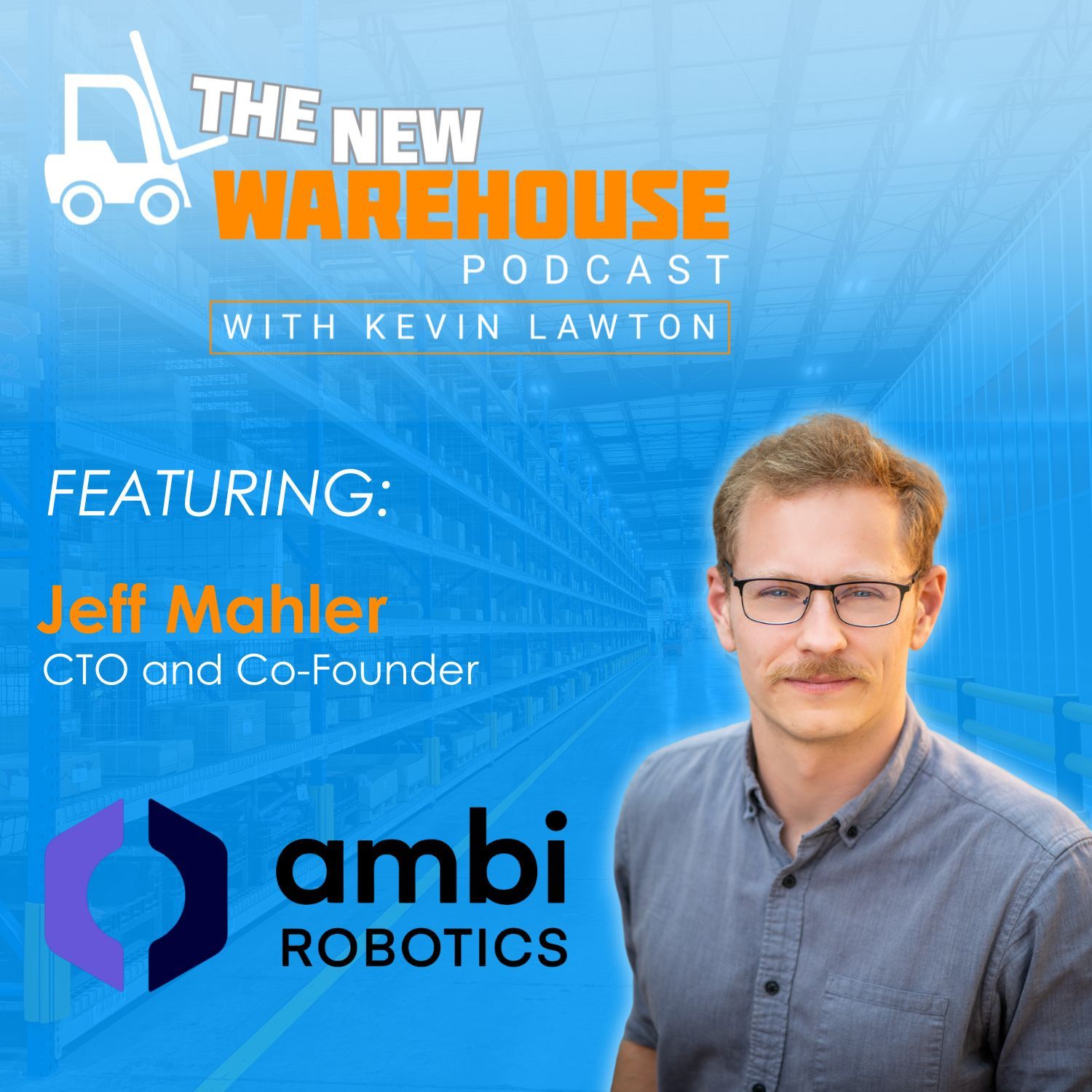
613: Reinventing Warehouse Stacking with Ambi Robotics
In this episode of The New Warehouse Podcast, Kevin chats with Jeff Mahler, CTO and Co-founder of Ambi Robotics. Ambi Robotics applies artificial intelligence and simulation-driven learning to solve some of the most complex challenges in logistics automation. In this episode, Jeff shares how Ambi uses a combination of deep reinforcement learning, modular design, and real-world feedback to help operations scale productivity through robotic systems.
From parcel sorting to the latest innovation, AmbiStack, the company is building solutions that adapt and improve over time. This episode dives into the tech, the challenges, and what’s next for warehouse robotics.
Building Robots That Adapt Like Humans
Rather than chasing perfect day-one performance, Ambi Robotics builds systems that evolve. Jeff explains that “we’re building fully integrated machines…hardware, software, and support services to help people move items around.” The approach starts with simulation, where robot behaviors are trained in virtual environments just like a 3D Tetris game, before being deployed into the real world.
The AI lifecycle follows three stages: simulation, supervised learning, and unsupervised learning. That process allows the system to get smarter in production. As Jeff puts it, “We’ll do what we call supervised learning to update the model from the experience.” By focusing on adaptability, Ambi robots work alongside people and enhance productivity, not replace it.
Ambi’s parcel sorting robots have already sorted over 100 million items in the field, creating a “data moat” that powers continuous AI improvement. Their modular platform, AmbiOS, combines interchangeable components like robot arms, cameras, and end effectors with a growing library of AI skills that include material analysis and quality control.
Solving the Hard Problem of Stacking
Stacking may seem simple to humans, but it’s one of the most challenging tasks for robots. AmbiStack tackles this by integrating sim-to-real reinforcement learning that trains robots to place parcels densely and stably without knowing what’s coming next. Jeff calls it “a video game like 3D Tetris, where the robot is gonna get a stream of random boxes…and over time, the algorithm will learn how to place those boxes to get a higher score.”
The real-world form factor gives the robot options. For instance, with a gantry-mounted arm above a conveyor, AmbiStack can stage items, look ahead using scanners, and choose the best placement strategy. This optionality, Jeff says, is critical: “the robot can stage a lot of items on that conveyor so that it has more options of what to place when.”
Ambi’s doesn’t expect customers to wait for results. They run simulations to set benchmarks for Day One and performance over time. “We’ll come up with different phases…try to set those expectations also in a way where we can exceed them,” Jeff notes. For many users, AmbiStack can deliver ROI in just one to 1.5 shifts.
What’s Next for Ambi Robotics in the Warehouse?
Looking ahead, Jeff sees warehouse robotics moving beyond traditional automation and into areas like mobile manipulation. “One of the interesting areas that we’re excited about is mobile manipulation…you’ve got an arm on a mobile base moving around.” He cites Boston Dynamics, Brightpick, and Locus as examples advancing in this space.
Ambi’s next moves will extend stacking solutions to new applications—like case picking and shelf management. Their flexible systems are already opening doors in receiving areas, where robotic stacking can streamline truck unloading and palletizing. Jeff notes, “there’s still a lot of opportunity…even in our world, there’s cartons going on to racks and people moving around in that space.”
Whether it’s solving last-mile sorting or shelf-level integration, Ambi Robotics is committed to building robots that learn, adapt, and elevate human productivity across the supply chain.
Key Takeaways
- Ambi Robotics trains warehouse robots using simulation and reinforcement learning to solve real-world logistics challenges.
- Their platform AmbiOS combines modular hardware with AI “robot skills” like picking, placing, and damage detection.
- Over 100 million items have been sorted in the field, creating a data moat to improve reliability.
- AmbiStack uses reinforcement learning to pack parcels densely—even when item dimensions are unknown.
- Their foundation model, Prime1, was trained on over 20 million images to support a wider variety of item handling.
- Ambi’s robots can deliver ROI in just one to 1.5 shifts, especially in high-volume environments like truck unloading.
- The company sees future expansion in mobile manipulation and shelf-level storage automation.
Listen to the episode below and leave your thoughts in the comments.
Guest Information
For more information on Ambi Robotics, click here.
To connect with Jeff on LinkedIn, click here.
For more information about robotics in warehousing, check out the podcasts below.
612: Boosting Warehouse Productivity with Vecna Robotics
605: Trailer Loading with Modular Simplicity from Slip Robotics
MHI Industry Group Series: Shaping the Future of Robotics in Warehousing

Warehouse Robots Maintenance: Roboworx Extends Fleet Life
[…] 613: Reinventing Warehouse Stacking with Ambi Robotics […]
Anscer Robotics Expands Hybrid Warehouse & Factory Automation
[…] 613: Reinventing Warehouse Stacking with Ambi Robotics […]
To Bot or Not: Lessons on Robotics from WERC 2025 » The New Warehouse
[…] 613: Reinventing Warehouse Stacking with Ambi Robotics […]